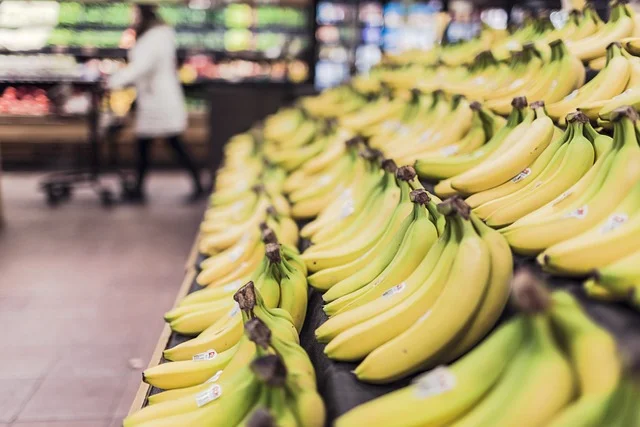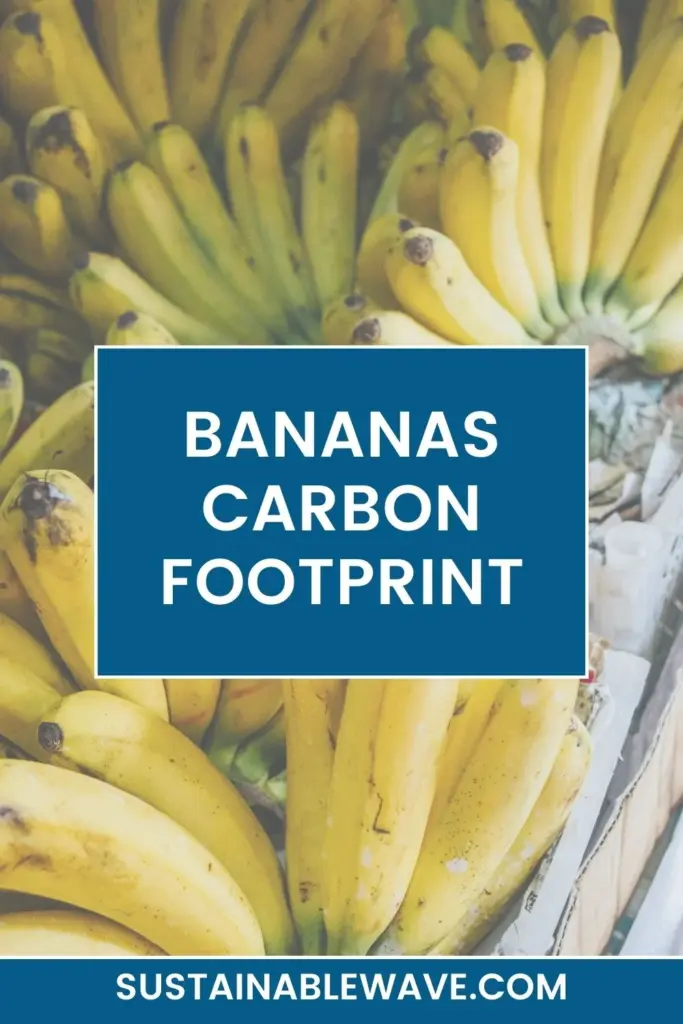You might’ve heard about carbon footprints, those pesky little markers of environmental impact that many industries face scrutiny for. But have you ever considered the carbon footprint of your breakfast fruit?
Bananas have a low carbon footprint of 80g CO2e each or 480g CO2e per kilo. They’re grown in natural sunlight, transported by low-emission boats, and require minimal packaging. However, the prevalent use of the ‘Cavendish’ variety and associated farming practices have environmental concerns.
Let’s unpeel the facts about the banana carbon footprint in the US.
Banana Carbon Footprint In The US: The Basic Facts

Every step from a banana’s growth to its appearance on your dining table leaves an environmental footprint. In the US, bananas travel long distances before reaching consumers.
These transport miles combined with cultivation practices contribute to the banana’s overall carbon emissions.
Growing Regions and Carbon Contribution
Bananas, one of the world’s most beloved fruits, have a complex journey before reaching our breakfast tables. The major chunk of bananas consumed in the US comes from Central and South America, predominantly countries like Ecuador, Costa Rica, and Honduras. These regions provide the tropical, humid conditions that bananas need to flourish.
However, this geographical separation between production and consumption zones has a direct impact on the banana’s carbon footprint. While the farming practices themselves do contribute to CO2 emissions, especially with the use of fertilizers and deforestation, it’s the distance between these growing regions and the US market that significantly exacerbates their carbon contribution.
Add to this the fact that bananas are perishable, necessitating swift transportation, and you’ve got a recipe for a sizable carbon output. This situation highlights the importance of examining not just the environmental costs of production but also the environmental implications of our global supply chains.
Transportation: A Major Carbon Culprit
The need to transport bananas swiftly from their growing regions to the US market puts a significant strain on our environment. Given the perishable nature of bananas, swift transportation becomes a necessity, often relying on airplanes, which are notorious for their carbon emissions.
Even when shipped, which is a more common method, the long journey across seas contributes to CO2 emissions.
Once they reach the shores of the US, these bananas often have to be transported across the country to various distribution centers and then to retail outlets. This domestic transportation further uses trucks, adding to the carbon tally.
While one might argue the actual per-banana emissions might seem minuscule, considering the sheer volume of bananas imported and consumed, these small contributions add up quickly.
As consumers grow more eco-conscious, there’s a push towards identifying transport solutions that minimize the carbon footprint without compromising the quality and availability of the fruit.
Storage and Retail
Once bananas make their journey to the US, their carbon tale doesn’t end. To ensure that bananas remain fresh for consumers, they are often stored in specialized refrigerated facilities. These facilities maintain a controlled temperature and humidity level to prolong the shelf-life of bananas.
However, the energy required to power these cooling systems, especially when relying on non-renewable energy sources, adds to the banana’s carbon footprint.
Additionally, when bananas reach the retail space, further resources are expended. From the lighting and temperature controls in the stores to the plastic bags used for packaging, every step has its carbon cost.
Moreover, consider the discarded bananas – those that don’t meet the aesthetic criteria or get overripe. These discarded fruits, often in significant amounts, represent not just food waste but also wasted resources and increased carbon emissions. For a true eco-friendly banana consumption experience, it’s essential to address these post-transport stages as well.
Banana Waste: An Overlooked Contributor
When pondering the environmental impact of our foods, we often focus on production and transportation. Yet, a hidden but significant factor contributing to the banana’s carbon footprint is waste.
Each year, tons of bananas are discarded, whether for being too ripe, having blemishes, or simply because they don’t meet certain aesthetic standards. This waste isn’t just about the fruit itself but represents a culmination of resources – from water to human labor to transportation energy – all for naught.
Landfills brim with discarded bananas, which, when they decompose, release methane, a greenhouse gas far more potent than carbon dioxide. It’s a double whammy: not only are resources wasted in producing these discarded bananas, but their decomposition also adds to the greenhouse gas problem.
Addressing the issue of banana waste could significantly reduce the overall carbon footprint of this staple fruit and is an essential step toward a more sustainable food chain.
Consumer Habits and Footprint
Every time we purchase a banana, we play a role in its environmental narrative. Our habits, often influenced by a mix of cultural norms, marketing, and personal preferences, have repercussions for the planet. For instance, the demand for perfectly shaped, spotless bananas leads to significant waste, as ‘imperfect’ bananas are discarded.
Then there’s the way we consume and dispose of bananas. A banana not consumed in time and thrown away adds to household food waste. How we dispose of the peels, whether through composting or trashing, determines their environmental impact. If composted, they return nutrients to the soil; if trashed, they contribute to landfill emissions.
Moreover, the push for convenience has seen a rise in pre-packaged banana products, from dried banana chips to pre-sliced banana packs. These often involve additional processing, packaging, and thus, a greater carbon footprint. By being mindful and making informed decisions, consumers can drastically reduce the carbon footprint associated with their banana consumption.
Reducing the Footprint: Possible Solutions?
The carbon trail of bananas might seem daunting, but there are tangible solutions to mitigate the impact. One major solution lies in supporting local producers. While the US might not be the tropical paradise bananas need, certain regions can support their growth. Local cultivation cuts down on transport emissions dramatically.
Furthermore, encouraging farms to adopt green practices can make a difference. This includes sustainable water management, organic farming without harmful pesticides, and reforestation efforts. On the transportation front, investing in cleaner transport methods and optimizing supply chains can reduce emissions.
For retailers, initiatives to sell ‘imperfect’ bananas or to process them into other products before they go bad can reduce waste. On the consumer front, buying responsibly, reducing waste, and composting can make a dent in the footprint. The journey to a smaller banana carbon footprint is a collective one, requiring the effort of producers, retailers, and consumers alike.
Global Comparisons

When we look at the carbon footprint of bananas in the US, it’s essential to place this data in a global context. Bananas are consumed worldwide, and their carbon trail varies depending on factors like transportation, production practices, and consumer behaviors.
By making international comparisons, we can glean insights into best practices and areas for improvement.
- Ecuador:
- Ecuador is the world’s largest banana exporter, supplying a vast portion of global demand.
- Due to proximity, transportation emissions from Ecuador to neighboring countries like Colombia or Peru are relatively lower than to distant markets like the US or Europe.
- However, intensive farming practices, often aimed at meeting high export demands, can increase the carbon footprint at the production phase.
- India:
- India is one of the top banana producers globally, but the majority of its produce is consumed domestically, reducing transportation-related emissions.
- Traditional farming practices in some regions might be more sustainable, but there’s a push towards modernization which could increase the carbon footprint unless managed responsibly.
- The Philippines:
- A major exporter to countries like Japan and China, the Philippines grapples with balancing high production with sustainable practices.
- The shorter distance to Asian markets compared to the US means reduced transportation emissions, but the sheer volume of production can offset this benefit.
- Costa Rica:
- A significant portion of bananas consumed in the US originates from Costa Rica.
- While the transportation emissions to the US are considerable, Costa Rica has been pioneering sustainable farming practices, including water management and reduced pesticide use, which could offset their overall carbon footprint.
- Belgium:
- While not a producer, Belgium is a significant importer and re-exporter of bananas in Europe.
- Bananas reaching Belgium have transportation emissions associated with their journey, but re-exporting them, especially via road or rail, adds another layer of carbon footprint.
By comparing these countries, we see a mixed bag. While transportation emissions play a significant role in countries exporting to distant markets, production practices are equally crucial.
Sustainable farming can counterbalance the carbon costs of transportation, emphasizing the need for holistic approaches to reduce the global banana carbon footprint.
Banana Carbon Footprint Calculator
Bananas are the world’s most popular fruit and are produced in large quantities across tropical countries. However, their production and transportation contribute to their carbon footprint.
Bananas have a moderate carbon footprint, with each pound of bananas producing about 0.48 pounds of CO2 equivalent emissions. This includes factors such as transportation fuel, pesticide use, and the creation of plastic waste.
Every stage of a banana’s lifecycle, from farming practices that may involve deforestation and heavy use of fertilizers, to packaging, shipping across the globe, and disposal of waste, releases carbon dioxide (CO2) and other greenhouse gases. Additionally, the refrigeration required to keep bananas fresh during transport consumes energy, further increasing their carbon footprint.
It’s important to note, however, that compared to other commonly consumed foods, especially meat and dairy products, bananas have a relatively low carbon footprint. Encouraging sustainable farming practices and efficient transport methods can help further reduce the carbon footprint of bananas and contribute to global sustainability goals.
The Banana Carbon Footprint Calculator is a simple yet powerful tool that allows us to quantify the environmental impact of our dietary choices.
By inputting the weight of bananas consumed, you can estimate your carbon emissions associated with this fruit.
This underlines the fact that even seemingly inconsequential choices, like the fruit we eat, contribute to global carbon emissions.
Banana Carbon Footprint Calculator
The Banana Carbon Footprint Calculator is a simple yet powerful tool that allows us to quantify the environmental impact of our dietary choices.
By inputting the weight of bananas consumed, you can estimate your carbon emissions associated with this fruit.
This underlines the fact that even seemingly inconsequential choices, like the fruit we eat, contribute to global carbon emissions.
Using this calculator, it becomes evident that opting for locally grown, organic, and plastic-free bananas can significantly lower our individual carbon footprints.
Remember, every small step we take towards sustainable living has a cumulative effect on our planet’s health.
What Is the Cavendish Banana?
The Cavendish banana, dominating global markets, is the primary variety consumed worldwide. It came to prominence after the “Gros Michel” variety was decimated by Panama disease in the mid-20th century.
Boasting a creamy texture and sweet flavor, Cavendish bananas exhibit a vibrant yellow peel upon ripening and thrive in tropical climates. Their dominance arises from their disease resistance and extended shelf life. However, this monoculture presents environmental challenges.
Relying heavily on a single variety exposes the industry to potential collapse if the Cavendish were to be struck by a disease it couldn’t resist. Moreover, intensive farming practices, often aiming for maximum yields, have been linked to environmental degradation.
Large-scale Cavendish plantations sometimes involve deforestation, and the liberal application of pesticides and fungicides poses threats to both ecosystems and plantation workers. Such practices spotlight the urgency for diversified, sustainable banana farming.
FAQs
How are carbon footprints calculated for products like bananas?
Carbon footprints are typically calculated by analyzing the entire lifecycle of a product. For bananas, this includes growth, transport, storage, retail, and waste management.
Why are transportation emissions a major concern?
Bananas for the US market mainly come from distant regions. The longer the transport distance, the higher the carbon emissions.
Do organic bananas have a smaller footprint?
Generally, organic farming practices are more sustainable, which can lead to a smaller footprint. However, transport still remains a significant factor.
How can consumers reduce their banana carbon footprint?
Supporting local producers, composting, and being mindful of waste are some ways consumers can help.
Are there any certifications that ensure a lower carbon footprint for bananas?
Yes, some certifications like Fair Trade or Rainforest Alliance can indicate more sustainable practices, though not exclusively related to carbon footprints.
What’s the future for bananas in terms of carbon emissions?
With growing awareness and technological advancements, there’s hope that the banana industry will adopt more sustainable practices, reducing its carbon footprint.
Conclusion

The banana carbon footprint in the US serves as a microcosm of the broader environmental challenges we face.
While it’s just one of many food items we consume, its story resonates with the global call for sustainability.
By making informed choices, consumers can play their part in reducing this footprint, making every bite of that delicious banana count!
Sources
- The U.S. Environmental Protection Agency (EPA) – Website: EPA’s Carbon Pollution Inventory
- The Union of Concerned Scientists (UCS) – Website: UCS on Global Warming
- The World Resources Institute (WRI) – Website: WRI’s Climate Program
I’m Thomas, the owner of SustainableWave. Passionately promoting a sustainable planet. With experience in various eco-roles, I’ll share green tips, sustainability hacks, and personal eco-journeys on my blog.






